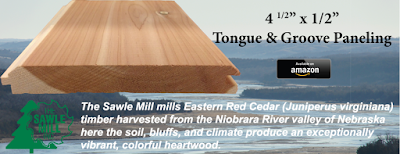This may not seem like a
groundwater story. But it is….
A couple of years ago my wife and
I started talking about a master bath remodeling project. When I went up in the attic to look behind
the wall, I noticed a lot of unused space adjacent to the bathroom and the
master closet. As an avid DIYer, an idea
formed: I suggested the attic space
could become a cedar storage closet. So
the idea grew into a project, and I re-worked the master closet to install a
door for attic access.
Now fully committed with a door
to nowhere, I had to source the materials. I figured I’d just buy the cedar from my local big box store, but they
sold thin “closet liner” material that was made to be glued or nailed into an
existing closet, and I wanted something more substantial…1/2-inch tongue and
groove walls and 3/4-inch tongue and groove flooring. Courtesy of Google I found a couple of
sawmills that sell directly to consumers, and one of them was very interesting
because of the Nebraska connection I have with the Groundwater Foundation. Here’s what I found on their website:
“The Sawle Mill buys and mills timber grown in Nebraska. Our Eastern Red Cedar (Juniperus virginiana) is primarily harvested from the Niobrara River valley where the soil, step bluffs, and climate combine to produce exceptionally vibrant, colorful, heartwood.”
 |
| https://sawlemill.com/ |
 |
| https://sawlemill.com/ |
Curious, and
interested in knowing how my choices affect the environment, I didn’t stop
there. It turns out juniperus virginiana is native to the US from the Plains
east to the Atlantic and south to the Gulf. It is a pioneer species, which means that it is one of the first trees
to repopulate cleared, eroded, or otherwise damaged land, and it is especially
long-lived. (Hmm, maybe I don’t want to
cause it to be cut.) But in many areas
near pasture or cropland, it is considered an invasive species, even if native.
It is fire-intolerant, and used to be controlled by wildfires. Especially in
Nebraska, fires have been stopped with roads, plowed fields, and other fire
breaks, allowing red cedar to invade and grow where it is unwanted. (Okay, invasive is bad, so I might be
helping!)
 |
| https://agronomy.unl.edu/eastern-redcedar-science-literacy-project/invasion |
Not to mention the end-use: beautiful, useful, aromatic, and pest-free storage closets like ours!
__________
Chris Barnett is the Executive Director of the Lawrence Community Development Corporation, as well as the team leader for the Indianapolis-Marion County Groundwater Guardian Team, the Marion County Wellfield Education Corporation. Chris also serves on The Groundwater Foundation's board of directors. Reach Chris at cbarnett.lcdc@gmail.com.
The views expressed in this blog are those of the authors and do not necessarily represent the view of The Groundwater Foundation, its board of directors, or individual members.


No comments:
Post a Comment